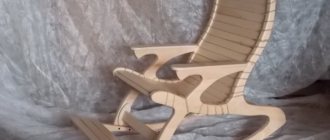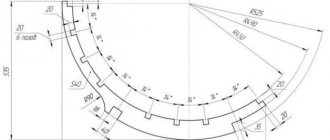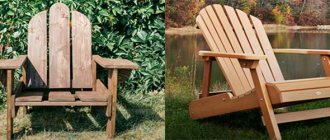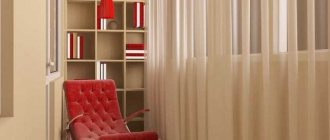What you need to make a bean bag chair with your own hands
An ottoman chair with and without a back (with your own hands) is made according to a pattern. You need to prepare it or find it in advance, select materials and fillers. There are many ready-made patterns online, all you have to do is choose. You can attend a specialized master class or watch a video.
To work on a bean bag chair you need to prepare:
- fabric - a piece of fabric for sewing the inside of the product, you can choose cheap, simple textiles, average length 2.5 m, width 1 m or more;
- a cut for external finishing, the fabric should be durable and beautiful, preferably not easily soiled and can be cleaned;
- a pair of zippers for fastening a removable cover, the length of each tape is about a meter, sometimes zippers are replaced with Velcro;
- graph paper with a simple pencil for a pattern, if you do not want to use a ready-made pattern;
- polystyrene for stuffing the finished bean bag chair.
A bean bag ottoman is sewn together from fabric blanks. It is optimal to use a sewing machine.
Important! Natural padding materials like hay are not suitable for bean bag chairs because they conduct moisture. Bean bag chair - beautiful DIY interior decor
Frameless chair that can change shape
Such products consist of several pillows fastened together. These interior elements have many advantages.
They are as follows:
- A light weight. To make transformable furniture, timber, plywood and heavy pressed boards are not used. The chair can be easily moved to a new place when the need arises.
- Safety. The accessory does not have hard surfaces or sharp corners that children can hit. When unfolded, the height of the soft part above the floor does not exceed 20 cm - a child falling in his sleep will not cause him any discomfort.
- Presentability. Properly made and tastefully decorated furniture looks beautiful and representative, fitting organically into the interior.
A folding chair without a frame is easy to maintain and repair. It can be easily disassembled into component parts that can be quickly replaced or updated.
What you need
Before starting work, it will be necessary to conduct a survey of the premises and draw up diagrams. You need to measure the size of the free niches and the area that can be occupied by furniture. If you make several identical items, you can use them to assemble a sofa or corner for spending time together with your child’s family or friends.
To make a child seat with your own hands, you will need to accurately calculate the need for materials. It is advisable not to skimp on fabric and make all pillows the same color on both sides. This way the furniture will look much better when unfolded.
You can calculate the pattern of a frameless chair using paper copies of each pillow and ottoman to scale. The cut rectangles are laid on the fabric roll strip layout so that there is less waste. Separately, it is advisable to add a supply of material to the calculations for replacement in case of damage to the product.
Materials and tools
To make a chair with your own hands you need the following materials:
- foam rubber slabs 10 cm thick;
- upholstery fabric;
- inexpensive chintz;
- braid 2 cm and 5 cm wide;
- threads;
- detachable zippers;
- decorative elements;
- synthetic glue.
Tools needed to make a chair:
- sewing machine;
- tailor's meter;
- roulette;
- scissors;
- stationery knife;
- marker or pencil.
Since the foam rubber will have to be cut with a sharp knife, it is recommended to protect the floor covering while working. For this, plywood or a piece of old linoleum is used.
Sewing order
To make upholstered folding furniture, you must have a sufficient supply of needles and threads.
Sewing covers is carried out in the following sequence:
- A strip of material is spread on the floor. If there is such a possibility, it is better to fix it tightly in the corners in a taut state.
- The patterns are transferred to the fabric. It is advisable to place the templates on the same line in order to obtain several blanks with one cut. The details of the pattern are made clearly visible. The part marking is applied on the reverse side.
- The marking is checked for correctness. After this, the material is cut with scissors. The excess is removed, and the blanks are stacked.
- The edges of the workpieces are finished using an overlocker. The covers are sewn together, zippers and wide braid are attached to them.
To strengthen the edges of the pillows and give the correct shape, sew narrow braid along the corners of the covers.
You can sew a bean bag chair with your own hands in the same way. Since it has a rounded shape, the seams do not need to be reinforced with braid.
Filling the filler
For a pear-shaped product, an inner cover is made of thick fabric. It is necessary to retain small fragments and dust. Foam balls, polyethylene or polyvinyl chloride can be used as filler. All these materials are environmentally friendly and are sold on construction markets.
To fill the cover, 0.3-0.5 m³ of material is required. To accurately calculate the need, you need to multiply half the length of the rounded part by the width and depth of the base. It is recommended to purchase balls with a reserve of 20-30% in order to add them to the case as the filler shrinks. Backfilling is carried out using a scoop; the completeness is determined experimentally. The receiver of the work is the child. After filling the inner reservoir, it is zipped up and the outer cover is pulled over the top.
Patterns of bean bag chairs with dimensions
The bean bag chair cover pattern can be of any size, it all depends on personal preferences and the availability of materials. They draw it themselves, taking into account optimal measurements, or use a ready-made one. For independent “drawing”, it is convenient to use graph paper; it is easiest to transfer markings to fabric. The parts are cut out along the contours.
The pattern of a bean bag “drop” for an adult includes:
- 6 wedges 40 cm at the ends, 15 cm wide, 130 cm long, 50 cm in diameter;
- diamond-shaped top - 15 cm on each side;
- diamond-shaped bottom - 40 cm on both sides.
To get a beautiful product, it is important to strictly follow the patterns. The measurements can be adjusted, the main thing is to maintain the proportions.
For the children's model of a bean bag, take 6 wedge-shaped parts:
- 90 cm height;
- 45 cm diameter;
- 40-22 cm width.
The finished bean bag chair includes an inner cover with a zipper and polystyrene foam filling. External covers are usually made of velor, leather, corduroy.
First stage - cardboard base
Do it once
:
I cut out about 50 frame parts from the walls of the boxes according to the template and many strips - about 2 cm wide. The cardboard is not very thick, single-layer, but durable.
Do two:
I glued double (!) strips where heavy loads are most possible, that is, the seat and back. I glued them with PVA glue, although you can also use simple stationery glue. Cardboard is not always smooth, so be sure to leave the glue to dry for 6-8 hours, pressing it with something heavy...
And... now we can already see what our sofa will be like!!!
During the manufacturing process, my husband had the idea to make a transforming sofa that could turn into two armchairs. And so they did!
Do three:
I glued plain thin paper onto the uneven parts of the workpiece. I measured the resulting parts and wrote down all the dimensions for future cladding directly on them.
What fabric is a bean bag chair made from?
Do-it-yourself frameless bean bags are made from the following fabrics:
- Oxford is a popular upholstery material, beautiful, wear-resistant, and does not absorb moisture. The fabric is pleasant to the touch, machine washable without problems, does not absorb foreign odors, dirt or dust. Oxford has an unusual texture, ideal for a bean bag chair
- Flock is a soft, velvety material, practical, durable, and wear-resistant. It is easy to remove wool, dirt, and unpleasant odors from its surface. Flock is a popular furniture fabric
- Artificial leather is easy to care for, comes in a wide range of colors, has high humidity, is not afraid of temperature fluctuations, and does not fade in the sun. Eco-leather - a practical and mid-priced option
- Microvelvet is a fabric available in a wide selection of shades, easy to care for, and has high technical characteristics. Microvelvet is a very “cozy” furniture fabric
Sometimes velor is used to sew a bean bag chair. This solution is more expensive, but beautiful and cozy.
The fabric of the bean bag chair cover should not be stained or abraded
Wheel made from tires
A great idea on how to reuse scraps of plywood and worn-out tires left after renovation.
- Place the tires side by side.
- Fasten together using large self-tapping screws.
- Be sure to cover the bottom tire with felt to avoid damaging the floor in the future.
- Make the back from plywood. Give it the desired shape. Also attach it with self-tapping screws.
- Choose thicker foam for the inside of the seat. Cut out a circle and fill the tire with it. Then cut out a larger circle to cover the top of the seat. You can use thinner foam rubber.
- Cover the back with foam rubber using a furniture stapler.
- Cover the chair with upholstery fabric.
Instead of upholstery, you can sew a cute quilted cover. The child will appreciate it!
Unfortunately, sometimes it is difficult to navigate the sizes and quantities of materials if you use leftovers. Try to create your own unique model.
First, evaluate your resources: what materials and tools do you have at your disposal? Is everything enough? Sit down for the drawings! Don't worry if the materials available to you are a little unconventional. Using imagination and enthusiasm, a child's chair can be made from anything.
What is upholstered children's furniture made from? Yes of all:
- Styrofoam;
- thick cardboard;
- old furniture cushions;
- foam rubber without using a frame;
- remnants of laminate or parquet;
- polyurethane foam;
- plastic bottles and much more.
Involve your child - he will give you a thousand ideas. Make the chair soft and cozy. Find fun prints that you think fit with your favorite little person's personality. This will be an unforgettable gift not only for a holiday, but also just because.
How to stuff a bean bag chair with your own hands
The following is used as a filler for a bean bag chair:
- Expanded polystyrene granules and foam rubber, a double effect occurs, the ratio is 7 to 3. Foam rubber is still relevant in furniture production, but it is better to use it in conjunction with expanded polystyrene
- Expanded polystyrene - granular balls are sold in bags; to fill the chair you need a couple of bags (depending on the size). Optimal filler, resistant to moisture, withstands maximum loads, does not absorb sweat and water. With polystyrene foam balls you can create comfortable upholstered furniture
- Beans, namely beans, peas. Natural materials absorb moisture and can attract rodents, but in general this option is also a workable one. Beans for stuffing are not a typical option, but real
- Rags - any old, no longer needed things will do. Rags are also suitable for stuffing if there are no other options at hand
It is desirable that the selected filling for a bean bag chair does not have the property of caking or bunching up in one place.
Expanded polystyrene granules are the optimal padding for a bean bag chair, but other options also exist
What materials can be used?
If you have decided to make furniture for the nursery yourself, then first of all you need to decide on the type of material that will be used. Basically, all children's furniture is made of wood or its derivatives, but plastic or metal elements can additionally be used, depending on the wishes and capabilities of the master.
Children's wooden bed
The material used to create homemade children's furniture must be:
- durable;
- durable;
- reliable;
- environmentally friendly.
Children's plastic furniture
Solid wood
The ideal option for creating children's furniture is pure wood, solid wood. This is the most natural and safest material for health from any point of view. It does not emit any harmful substances, which means you don’t have to worry about it. In addition, the wood is easy to work with, has high strength characteristics and can withstand the load that even very active guys put on it.
Bed made of solid beech
Typically, oak, beech, maple, pine, walnut and a number of other species are used to make wooden furniture. But the most budget-friendly, affordable and simple option is pine boards. Unfortunately, they are not designed for high loads due to their softness, but they will withstand the activity of children's games if you choose the thickness of the array wisely. The most durable types of wood are walnut and oak. Such furniture will be of no use even after many years of intensive use in a large family.
Rocking bed
Chipboard and MDF
This is a material quite often used to create homemade furniture, but it is not recommended to place such furniture in a children's room. The fact is that in the production of chipboard, very dangerous chemicals are often used, which can provoke the development of serious diseases or an allergic reaction. These components are especially dangerous for children.
But chipboard is distinguished by its high strength and durability, as well as its low price. Fortunately, there are high-end slabs on sale that are used in Europe for furniture production. They are as safe as possible for people, including children’s health, and they can be used. But this is the most expensive option for chipboard, so sometimes it will be cheaper to buy even solid wood.
Children's furniture made of chipboard
By the way, there is another material that is produced almost in the same way as chipboard - MDF panels. They are also made from sawdust, but no resins containing dangerous formaldehyde are used during production. In terms of other properties, MDF is very similar to chipboard.
Chipboard and MDF
Plywood
This is a good and inexpensive material for creating children's furniture, easy to work with and not as dangerous as chipboard. Making anything from it is easy and simple; you don’t have to spend a lot of effort or purchase expensive equipment. But you should choose those sheets of plywood that are of fairly good quality and at least 1.5 cm thick. It is also better to choose an option that has increased resistance to water.
Children's furniture made of plywood
How to make a bean bag chair with your own hands
The outer bag is made from high quality materials; if you ignore the requirement, the design will turn out to be weak, rather tacky, and short-lived. Considering that it takes a lot of time to build a homemade chair, it will simply be a pity.
Important! If there are cats and dogs at home, the material of the cover should not attract fluff and hair.
Synthetic upholstery is preferable to natural upholstery; it has good resistance to mechanical and other influences, is easier to wash, and is not prone to stains that are difficult to remove. The downside of synthetics is that they can irritate sensitive, baby skin. Light-colored fabrics are used only for those that are easy to wash, since the need for washing arises frequently. Strong threads are used to sew the bags.
Important! When choosing a pattern, take into account the size of the room; in a large one, a small pouf will get lost, and in a narrow and chambered one, a large bag will visually clutter up the space.
How to sew a bean bag chair for adults
Sewing a bag with your own hands involves several stages. There is nothing complicated, the main thing is strict adherence to the sequence of actions:
- Prepare a pattern, make sure that the measurements are optimal, select materials and colors.
- Draw the pattern onto the fabric using a marker or chalk.
- Sew the inner bag, insert Velcro or a zipper into it, and sew the bottom.
- Make the outer bag in a similar way, taking into account that it should have increased dimensions.
- Fill the inner bag tightly with polystyrene or other selected material. Ensure that the padding is evenly distributed over the entire area.
The last point is that it is advisable to carry out the work not indoors, since otherwise synthetic filler will accumulate in the room, and this is undesirable and is fraught with allergic reactions.
How to sew a beanbag for children
The first stage is preparing the pattern. Further algorithm:
- Fasten the parts together with needles, baste the seams on the sides.
- Make stitches on a sewing machine, iron everything thoroughly with an iron.
- Place the outer wedges on the blanks and sweep.
- Make an inner cover, provide a zipper on one side up to 40 cm in length, through which the filler will be filled. Finish the seams with an overlocker.
- Prepare a removable outer cover and sew a zipper up to 1 m in length into it.
- Turn a couple of covers inside out and sew the top to the outer one.
- Turn the face inside out and fill with filler.
It is advisable to add polystyrene foam balls from time to time. It is highly not recommended to install the product near heating devices. Contact with direct sunlight is undesirable, since it also changes the original performance properties of the products.
DIY bean bag chair
The ball is a bright and stylish model; it will decorate any interior in which it is used. First, they make patterns for the outer and inner bags - the patterns can be found online.
Progress:
- The parts are sewn together and a zipper is sewn in.
- They check the strength of the seams, the quality of the zipper, and its compliance with the dimensions of the model.
- Fill the case with filler and shake it to distribute it evenly.
The bags must be sewn together. The shape is made strictly round, like a ball
DIY triangular bean bag chair
The triangle bag is made according to the same pattern as other options, but the pattern should have stricter lines and a tapered top. Procedure:
- Prepare a pattern, transfer the patterns to the fabric.
- Cut out the blanks, sew the seams on a machine, and iron them thoroughly.
- When the inner and outer covers are ready, sew them together and check the strength of the structure.
- Fill the bag with the selected filling.
The top of the triangle needs to be filled in, otherwise it won’t “stand” clearly.
DIY knitted bean bag chair
If you have the desire and the appropriate skills, the chair can be made using knitting. This pouf looks very beautiful in any interior and can have different colors. The height will be lower than that of a chair and other furniture, the shape is usually like a cube.
Procedure:
- Prepare a pattern with measurements - this will be more of a plan for action.
- Take thick yarn and knitting needles about 15 mm. The composition of the yarn is not important, but it needs to be thick.
- Start knitting the cover, optimally with garter stitch, but other techniques can also be used.
- Close the finished fabric along the width with a needle or hooks.
- Stuff the material inside and sew it together.
Additionally, you can make a cover from knitwear. Instead of knitting needles, some craftswomen use a crochet hook.
DIY bean bag chair made from jeans
Old jeans are a practical option for sewing the outer cover of a homemade chair. If you don’t want to wear it, but it’s a shame to throw it away, you can give the item a second life. The fabric is dense, wear-resistant, so it will last a long time.
Procedure:
- Prepare a pattern - the shape can be any, triangle bags come out well from denim.
- Prepare tools and materials for working using the patchwork technique, since you will have to sew a lot of elements together.
- Cut the trousers into rectangles, there should be a minimum of scraps, and process the edges of the blanks using an overlocker.
- Sew the cover using pins, making the seams overlap. You can combine homogeneous pieces or play with contrast.
- Fill the capsule with polystyrene or other filler.
Done – close the previously sewn zipper. The main problem with jeans is that the fabric is very thick and dense, you will have to tinker with it longer than, for example, with oxford. They also use powerful lightning. But the efforts will pay off, the result will be stylish, bright and durable.
Children's chair made from scrap materials
The child seat can be made into a more traditional look. Such models can be seen in specialized stores and in artistic photographs. They are expensive and not available to everyone.
And around us there are a lot of unnecessary things and materials. It turns out that you can use them to build a beautiful soft chair for a child. In this case, the result is a classic model worthy of becoming a favorite piece of children's furniture.
Tools and materials
- Remains of plywood. To make the structure lighter, you can use foam.
- Hardboard. The leaf can be given a rounded shape.
- Chipboard planks.
- Bars.
- Drill with drills.
- Furniture screws.
- Clean corrugated cardboard.
- Knife for cutting paper.
- Sandpaper.
- Sewing machine.
- Ruler.
- Wood glue.
- Glue "Moment".
- Foam rubber.
- Upholstery material (you can combine different, matching colors or textures).
- Interlining or other technical fabric.
How to put balls into a bean bag yourself
When the cover for the bean bag chair with your own hands is ready, you can start stuffing it. Simply pouring polystyrene foam granules into a bag is a bad idea, since the filler is lightweight and will scatter to the sides. The correct diagram looks like this:
- Lower the top of the bottle with granules into the bag so that the neck is on the outside.
- Secure the position with tape or rope.
- Immerse the second part in the filler case and secure it.
- Place one part of the bottle into the second and begin filling the inner bag.
This is a simple and quick assembly scheme, all the granules will go exactly where they are supposed to go, and will not fly around the room. You can use the method when the bag shrinks and loses its original shape.
Expanded polystyrene granules are lightweight and like to scatter around the room, so you need to follow the rules for stuffing the bean bag cover and use bottles
How to care for a bean bag chair
Since the bean bag chair is used actively, the cover needs to be washed from time to time. This is an important component of caring for upholstered furniture, which is constantly in contact with the floor covering and the human body.
Important! To preserve the structure of the filler, its friability, softness, and washing are not done entirely. The cover on a bean bag chair must be removable.
There is a zipper for quick removal of the top of the bean bag chair. It must be strong enough, designed for numerous opening-closing cycles (otherwise it will have to be altered).
Covers for bean bag chairs can be washed, the main thing is to do it separately from the filling
A regular machine wash is suitable; the mode is selected taking into account the degree and nature of contamination. Stain removers can be used.
What you will need
This option is quite simple, just prepare all the necessary materials and tools in advance. In particular you will need:
- boards, at least one centimeter thick;
- foam rubber on most of the surface;
- construction stapler;
- screwdriver;
- self-tapping screws;
- upholstery fabric;
- ornaments for decoration.
If your child is very small, then in any case you should take thicker boards, because there is always the possibility that a heavier person could sit on the chair. Having prepared drawings and diagrams, you can easily make a chair of any format that you choose in advance.











